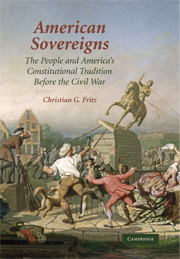Book contents
- Frontmatter
- Contents
- Acknowledgments
- 1 Prologue
- PART ONE THE PEOPLE'S SOVEREIGNTY IN THE STATES
- PART TWO THE SOVEREIGN BEHIND THE FEDERAL CONSTITUTION
- PART THREE THE STRUGGLE OVER A CONSTITUTIONAL MIDDLE GROUND
- 8 The Collective Sovereign Persists: The People's Constitution in Rhode Island
- 9 Epilogue
- Key to abbreviations
- Notes
- Selected Short Titles
- Credits
- Index
9 - Epilogue
Published online by Cambridge University Press: 31 January 2011
- Frontmatter
- Contents
- Acknowledgments
- 1 Prologue
- PART ONE THE PEOPLE'S SOVEREIGNTY IN THE STATES
- PART TWO THE SOVEREIGN BEHIND THE FEDERAL CONSTITUTION
- PART THREE THE STRUGGLE OVER A CONSTITUTIONAL MIDDLE GROUND
- 8 The Collective Sovereign Persists: The People's Constitution in Rhode Island
- 9 Epilogue
- Key to abbreviations
- Notes
- Selected Short Titles
- Credits
- Index
Summary
This book presented the history of an idea and of a people who tried to live by that idea before the Civil War – the idea we know today as American constitutionalism, defining “the people” as a collective sovereign. With Independence, Americans confronted how that collective sovereign could, like a king, speak clearly in one voice on local as well as on national concerns in a large and diverse country. One solution was to hear the voice of this sovereign through written constitutions.
This did not mean that the collective sovereign could be heard speaking primarily through a written constitution, as is the accepted wisdom today. During their Revolution and for a half-century thereafter, Americans were more open to the idea than we are today that a collective sovereign could rule without insisting on institutions or procedures to verify and discern the sovereign's will. This understanding made sense under an American constitutionalism that considered the people both the ruler and the ruled. But as memories of the Revolution faded, applying the principle of the collective sovereign's ability to act became a growing source of dispute.
The problem of determining the people's will was evident from the start, as illustrated by reaction to the news of Independence. John Hancock, president of the Continental Congress, wrote General George Washington on July 6 enclosing a copy of the Declaration of Independence.
- Type
- Chapter
- Information
- American SovereignsThe People and America's Constitutional Tradition Before the Civil War, pp. 277 - 302Publisher: Cambridge University PressPrint publication year: 2007

